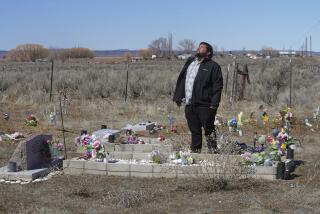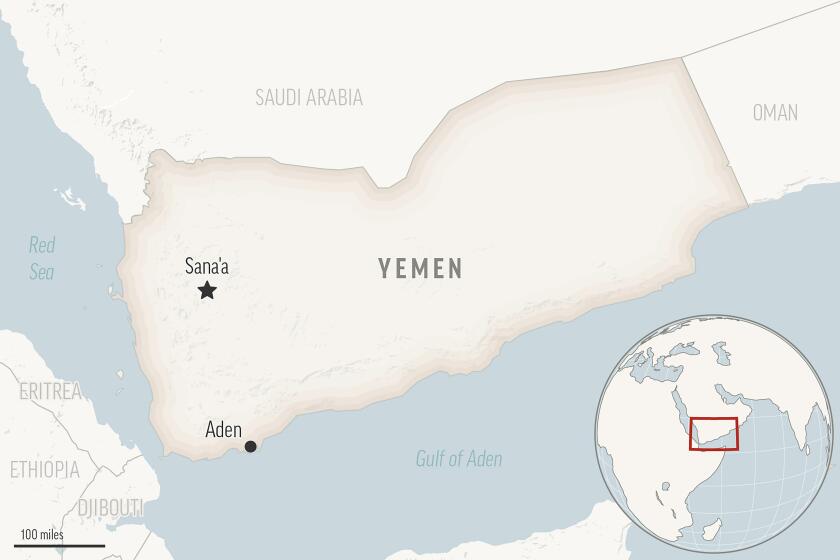Atoll, Site of Early U.S. Testing, Devastated by Nuclear Blasts : Bikini Islanders Fight Fallout, Bureaucracy in Bid to Go Home
- Share via
BIKINI, Marshall Islands — One day in March four decades ago, 167 men, women and children were loaded into U.S. Navy boats and taken away from the only home they had ever known, Bikini Island in the Pacific.
It was the dawn of the Atomic Age and the United States government was about to begin testing nuclear weapons in the isolation of Bikini Atoll’s lagoon.
Bikini would become synonymous with devastation.
12 Years of Testing
Between 1946 and 1958, 23 nuclear bombs were detonated in the pristine setting about 2,100 miles southwest of Hawaii in the Marshall Islands. Radioactive fallout contaminated the 2 1/2-mile-long, quarter-mile-wide Bikini Island, leaving it a poisoned paradise.
But ever since they were evacuated on March 7, 1946, the Bikini islanders, now numbering nearly 1,300, have longed to go home to what they remember as an idyllic island of white coral beaches and azure waters.
A year ago the Bikinians won an out-of-court settlement that commits the U.S. government to cleanse their island of the contaminated soil. Scientists say it can be done for upward of $50 million over a period of several years.
U.S. Favors Resettlement
The Reagan Administration and Congress say they favor moving the Bikinians back to their homeland and making the island livable again.
But, says Jonathan M. Weisgall of Washington, the Bikinians’ attorney, “No one has provided any money yet.”
“There is no doubt that they’ve been denied access to their homeland,” says Larry L. Morgan, spokesman for the Department of the Interior’s Office of Territorial and International Affairs, which has authority over the Bikinians’ affairs.
However, Morgan says, “Most of them have never lived on Bikini. The most that they know is what has been told them by their elders.”
U.S. Officials Visit
Morgan visited the island for the first time late last year, as did his boss, Assistant Interior Secretary Richard T. Montoya.
In a 1982 letter to President Reagan, Bikini leaders said, “We want to go back home and be Bikinians more than anything in the world. We want our dignity back and our dignity is our land. Our land is our life; to lose one is to lose the other.”
Bikini is the northernmost atoll in the Marshall Islands, an archipelago formed by coral formations built from submerged volcanic peaks. The Marshalls’ 29 atolls and five single islands are scattered over 375,000 square miles of the Pacific Ocean--an area about 1 1/2 times the size of Texas. But there is less than 70 square miles of dry land, about one-twentieth the area of Rhode Island.
The first nuclear test in Bikini Atoll, code-named Operation Crossroads, involved 42,000 military and civilian personnel, 242 ships, 156 airplanes, 25,000 radiation devices and 5,400 experimental rats, goats and pigs.
Single Bomb Detonated
One bomb was dropped from a plane into the center of 84 ships in the lagoon, which is 25 miles long and about 11 miles wide.
In a second test, the bomb was suspended beneath a ship and detonated electronically.
In 1954 came a test called Operation Bravo. At 14.5 megatons, it was the largest nuclear test in United States history. ‘Bravo” left a crater 1 1/2 miles wide and 480-feet deep in the lagoon. Three tiny islands were vaporized.
Fallout Contamination
“That brought Bikini back into the headlines,” Weisgall says. Radioactive fallout drifted eastward and contaminated several hundred Marshallese on two other atolls. The crew of a Japanese fishing boat also was hit by the radioactive dust.
In 1968, President Lyndon B. Johnson said Bikini again was livable and about 145 islanders moved back the next year.
However, they were moved out again in 1978 when tests showed that their internal radiation levels exceeded federal standards, Weisgall says.
Since then, no one has lived on Bikini Island.
Moved First to Atoll
The Bikinians’ odyssey 40 years ago first took them 125 miles east to Rongerik Atoll.
Lore Kessibuki, one of about 100 evacuated Bikinians still living, recalled: “When the Americans came to talk with us some of our people said, ‘Let’s not give up our island.’ But we did what the Americans said. As we were leaving they were very happy with us.”
“During the two years on Rongerik we faced starvation,” says the 77-year-old one-time Bikini magistrate, or mayor, and author of Bikini’s anthem. “The Americans left us with K-rations. They lasted about a month. We fought each other. The words the Americans told us on Bikini were lies. They said they would care for us. One woman died. My father got so weak he couldn’t stand or walk. Flesh hung from bodies. The elders laid around and felt sorrow.”
Six Months in Tents
When their plight was discovered, the Bikinians were sent to Kwajalein Island, where they lived in tents for about six months.
Then they were relocated on Kili Island, a 200-acre speck of land about 425 miles south of Bikini Atoll.
About 550 of the nearly 1,277 Bikinians live on Kili, where winter ocean storms wash waves over the narrow strip of land.
An additional 200 live on Ejit, another tiny island near Majuro, the Marshalls’ capital. About 300 live in Majuro, and the remaining Bikinians are scattered elsewhere in the Marshalls, a part of the Trust Territory of the Pacific Islands, also known as Micronesia.
Poor Area for Fishing
At Kili there is no lagoon. There is very little fishing because of the lack of sheltered waters. Most food is imported on the once-a-week commercial air flight from Majuro or by government ship.
On both Kili and Ejit islands, 15 to 20 people live in dwellings designed for less than half that many. There are no indoor toilets or plumbing.
There is little to do on Kili except go to church or walk around the island. Alcoholic beverages are forbidden.
One man imported a small truck he uses as a taxi. He charges 60 cents per person for a ride up and down the island or to the airstrip.
Handcuffs in Hot Sun
There is an eight-man police force, and anyone who gets out of line is handcuffed to a coconut tree under the tropical sun.
There is an elementary school, but the nearest high school is in Majuro.
The U.S. government provides Bikinians on Kili with canned food from the Department of Agriculture. Fresh fish, a staple in the Bikinians’ diet, is imported.
At 4.6% a year, the Bikinians’ birthrate is among the world’s highest. Weisgall says at least half of the Bikinian population is under 16 years of age.
Trusts Provide Income
Their income is from the interest on two trust funds totaling $6 million that Congress provided in the 1970s.
Weisgall says that amounts to about $600,000 yearly, or about $39 monthly for each eligible Bikinian. In 1980, Congress gave them a one-time, $1.4 million payment.
Morgan says that since 1964 the U.S. government has spent $46.3 million in studies and for support of Bikinians. That includes a $20.6-million resettlement trust fund.
$75 Million Payment Plan
Under recently passed legislation, the Bikinians are to receive $75 million in nuclear claims compensation over a 15-year period. Of the $5-million annual payment, Weisgall says $2.6 million will be put in trust. The remaining $2.4 million will be apportioned to the eligible Bikinians.
Last July, 17 Bikini men, including Kessibuki and another elder, Kilon Bauno, believed to be about 90, returned to Bikini Island to watch scientists’ experiments trying to rid the soil of radiation.
The soil and water specialists have determined that there is no threat of external radiation on either Bikini or Eneu Island, about four miles away.
Nearby Island Is Safe
They said there is danger from Bikini’s contaminated soil and brackish water, but Eneu could be resettled at any time because the soil is safe and fresh rainwater could be captured.
The scientists believe that through fertilizer, especially heavy doses of potassium, the radioactivity could be drawn out of the Bikini soil and crops could be grown.
At one time, scientists believed 10 to 12 inches of topsoil would have to be stripped from the land. Weisgall says that would be expensive and time consuming.
‘It’s Their Decision’
“They are going to have to use fertilizer, in any event, if the Bikinians want to grow crops,” Weisgall says. “The use of potassium would be cheaper, environmentally beneficial and they wouldn’t have to wait eight to 12 years to return. They might be able to get back in three to five years if they choose that route. It is their decision.”
The Bikini Atoll Rehabilitation Committee is an independent group formed by Congress in 1982 and given $3.8 million to spend to find a way to clean the island. The five-member committee, chaired by Dr. Henry I. Kohn, professor emeritus of radiation biology at Harvard Medical School, works with field teams from the Lawrence Livermore National Laboratory in Livermore, Calif.
In a report to Congress in November, the committee said the Bikini population could reach 1,600 by 1990 and 2,500 by the year 2000.
Overcrowding Seen
“Overcrowding on Kili and Ejit is already intense,” the report said. “Early relief is needed, and the Bikini people face the need to make decisions on alternative or additional temporary settlement locations well before Bikini Island is available for resettlement.”
The report also said the Bikinians “have been somewhat suspicious of BARC and especially work and statements by scientists in government laboratories.”
Some of that distrust evaporated after the Bikinians’ July visit to the island and other visits to Lawrence Livermore Laboratories, in Northern California, to watch scientists analyze soil samples from the island.
“From what I heard and watched on Bikini I was amazed and surprised,” Kessibuki said through an interpreter. “I’m so happy that I came. There isn’t any other country in the world that can be as smart as the United States. I think there will be positive results.”
Bauno, also speaking through an interpreter, said, “I don’t understand any of these tests. The only thing I understand is that our island was used for atomic tests and it is poisoned.”
“Don’t any of you forget us,” Kessibuki said.
More to Read
Sign up for Essential California
The most important California stories and recommendations in your inbox every morning.
You may occasionally receive promotional content from the Los Angeles Times.












